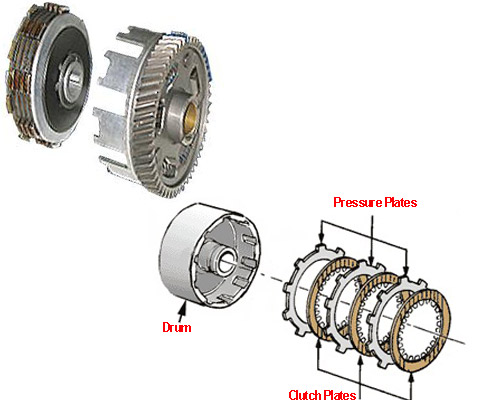What is a clutch?
In a geared motorcycle, the clutch is a crucial component that helps control the power transmission from the engine to the gearbox. It allows the rider to temporarily disengage the engine from the transmission, enabling smooth shifting between gears and coming to a stop without stalling the engine.
When the clutch lever is pulled, it disengages the clutch plates, interrupting the power flow from the engine to the transmission. This disconnection allows the rider to shift gears by using the gear lever without causing any damage to the gearbox or stalling the engine.
Once the desired gear is selected, releasing the clutch lever gradually engages the clutch plates, allowing the power to transmit from the engine to the wheels smoothly, enabling the motorcycle to move forward.
A properly adjusted and well-maintained clutch is essential for smooth gear changes and efficient power delivery in a motorcycle.

Wet Clutch
A wet clutch is a type of clutch system used in motorcycles, where the clutch plates are immersed in engine oil for lubrication and cooling. It’s called a “wet” clutch because it operates in an oil bath, as opposed to a “dry” clutch that doesn’t use oil for lubrication.
In a wet clutch system, the friction plates and steel plates are submerged in engine oil, which helps dissipate heat generated during clutch operation. This design aids in preventing the clutch from overheating and reduces wear on the clutch components, resulting in longer life and smoother operation.
The presence of oil in a wet clutch also contributes to smoother engagement and disengagement of the clutch plates, providing a more progressive and controlled transfer of power from the engine to the transmission.
Wet clutches are commonly found in many motorcycles due to their ability to handle higher torque loads, durability, and their capability to provide a smoother and more controlled operation compared to dry clutches.

Dry Clutch
A dry clutch is an alternate type of clutch system used in some motorcycles. Unlike a wet clutch, a dry clutch doesn’t operate in an oil bath; instead, it functions without being submerged in engine oil.
In a dry clutch system, the clutch plates (friction plates and steel plates) are exposed to the air and operate in a dry environment. They rely on friction between the plates for engagement and disengagement when the rider operates the clutch lever.
Due to the absence of oil, dry clutches tend to generate more heat during operation compared to wet clutches. This increased heat can lead to quicker wear and reduced lifespan of the clutch components.
Dry clutches are often lighter than wet clutches, which can contribute to reduced overall weight in the motorcycle. Some high-performance and racing motorcycles prefer dry clutches because they allow for quicker engagement and disengagement, aiding in rapid gear changes.
However, the trade-off for the performance advantages often includes increased noise during operation and a potentially shorter lifespan for the clutch components due to the heat generated without the cooling effect of oil.
Wet Clutch Vs Dry Clutch
1. Lubrication and Cooling:
• Wet Clutch: Immersed in engine oil, providing better lubrication and cooling, resulting in reduced wear and prolonged lifespan of clutch components.
2. Performance and Engagement:
3. Weight and Design:
4. Durability and Maintenance:
5. Applications:
Few motorcycles with Wet clutch systems
Few motorcycles with Dry clutch system

Which is better suited for Dubai’s climatic conditions?
In Dubai’s climate, which typically experiences high temperatures and arid conditions, a wet clutch system might be more suitable for motorcycles.
Wet clutches have the advantage of being immersed in engine oil, which helps with better heat dissipation and cooling. The lubricating properties of the oil can assist in reducing friction and heat buildup, which is beneficial in hot environments like Dubai. This can potentially enhance the lifespan of the clutch components and ensure smoother operation, especially in high-temperature conditions.
Additionally, wet clutches are generally less prone to the effects of dry and dusty environments compared to dry clutches, which might be affected by increased dust and debris in arid conditions.
Therefore, considering Dubai’s hot and dry climate, a wet clutch might be more practical and better suited to handle the environmental challenges presented by these conditions.
Conclusion
In summary, the choice between a wet clutch and a dry clutch in motorcycles involves trade-offs in terms of performance, durability, maintenance, and noise. Wet clutches offer better lubrication, smoother operation, and increased durability due to their oil-immersed design. On the other hand, dry clutches, commonly found in high-performance motorcycles, provide quicker engagement, reduced weight, but may require more frequent maintenance due to increased heat and friction. The selection between the two types often depends on the motorcycle’s intended use, rider preferences, and manufacturer’s design priorities.

